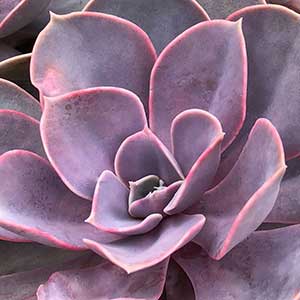Echeveria are native to Mexico, Central and South America and one of the real beauties of this group of succulents is Perle Von Nurnberg.

It is a hybrid, creates in the 1930s and is a cross between Echeveria elegans and Echeveria gibbiflora ‘Metallica’ and it is often simply called PVN.
Grown for the leaves which are a blue gray to purple and also the light dusting of Epicuticular wax or farina which give the foliage give the plant added attraction.
During summer, the foliage takes on a more of a pink to red colour and will flower as well with small pink and yellow flowers, however it is the foliage that Perl Von Nurnberg is grown.
This is a fairly easy succulent to grow and not difficult to propagate.
General Care for Perle Von Nurnberg
Like most Echeveria Varieties good drainage and good light are the most important factors. Good airflow is also important as this lowers humidity and therefore the risk of fungal infections.
Light
For good growth and colour, Perle Von Nurnberg requires good light, at least 6 hours a day. try for bright light with good morning sun, however not hot direct afternoon sun. This is a succulent that grows at high altitudes rather than a desert plant.
Indoors look for bright indirect light, keep the plant away from windows where direct afternoon sun may burn the foliage.
If PVN is in too much shade, the foliage can be more of green colour.
Temperature range
Temperatures should not drop below 45°f, freezes and heavy frosts should be avoided. An ideal temperature range would be around 60-80°f.
Some of the best colours appear in the winter months.
Watering
If you have a free draining potting mix, water deeply and then allow the soil to dry before watering again. You are trying to mimic the natural environment and these plants grow in very free draining soil, rocky slopes and similar.
During winter months water less frequently/
Use water that has been allowed to stand so fluoride etc have a chance to burn off and the water gets to room temperature.
Potting soil and Pots
A free draining succulent and cactus potting mix is essential as is a pot with good sized drainage holes.
You will only need to repot every second or third year, even less if you are using a good potting mix.
Fertiliser
It is sometimes said that succulents do not need fertilizer, however when growing in containers they do need some. A little slow release fertilizer added to the potting mix when repotting is usually adequate.
Varieties
Perle Von Nurnberg has a number of close relatives including:
- West Rainbow – A very attractive variegated type.
- Purple Perle – A darker version.
Pests
The usual pests such as mealy bugs, aphids and spider mites can all be felt with by using a Neem oil spray or a horticultural soap spray.
Problems
The only major problems are caused by overwatering and poor drainage, both of these can cause root rot and fungal disease.
Lack of light can cassette foliage to elongate or stretch, this is called etiolation.
We are asked
- Is Perl Von Nurnberg safe for cats? Yes the plant is not toxic for cats or dogs.
- Why are the leaves getting brown markings? This can be caused by sunburn. If the markings are soft and mushy, its caused by root rot setting in.
- How do I get the best colour from my Perle Von Nurnburg? Do not over fertilize, do not over water and expose the plant cooler temperatures in winter, but not frosts and freezes. Good sun in summer also helps.
Summary Information
- Botanical Name: Echeveria Perl Von Nurnberg
- Common Names : Succulent Perle Von Nurnberg. Pearl of Nurnberg.
- USDA Hardiness Zone: 10
- Soil/pH: Slightly acidic
- Light/Sun: Morning sun then Filtered Light at least 6 hours a day.
- Height: To around 6 inches tall
- Spread: To around 6 inches
- Growth Rate; Slow
- Flower Colour: White and Yellow
- Flowering Time: Spring to summer
- Foliage ; Grey blue to purple.
- Origins: A hybrid.

